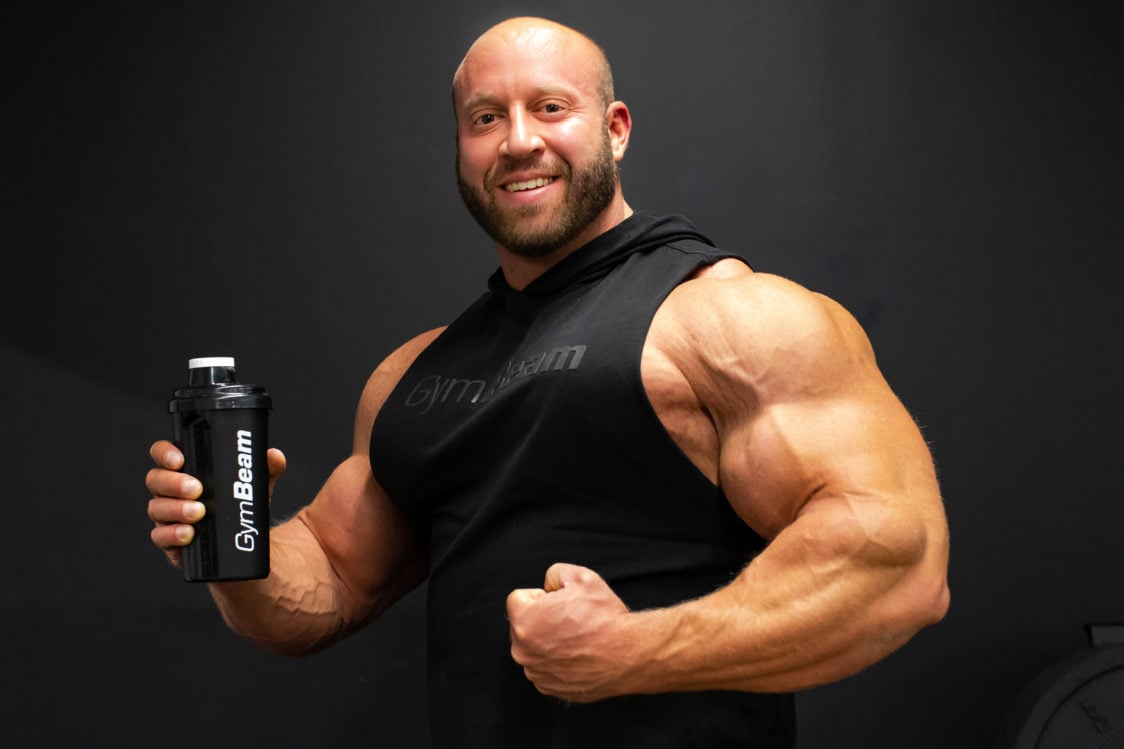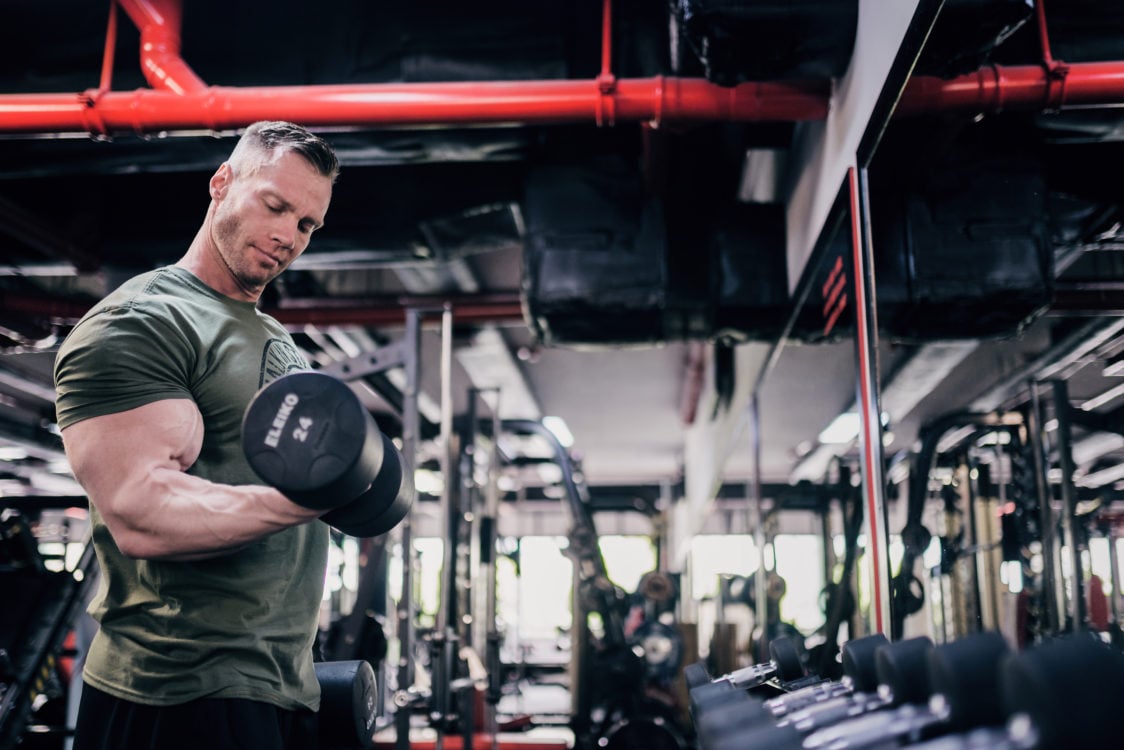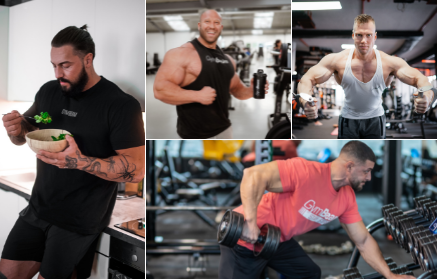Table of Contents
Growing muscle is a process that’s usually closely connected to the goal of getting the dream body. Gentlemen dream of a muscular body, broad shoulders and big biceps, while ladies usually strive for a leaner frame and sexy curves. Gaining some muscle mass is the way to achieve a more toned and attractive body, even for ladies, who can easily maintain their feminine charm. But building muscle requires time, patience, and long-term consistency.
Proper nutrition has to go hand in hand with training and regeneration time. These are the basics that can’t be denied. In today’s article, we’ll discuss and present some valuable tips for maximizing your muscle growth, helping you achieve your goals in the shortest time possible.
1. Get energy from healthy foods
A good training is something that requires a certain amount of energy. It’s a lot like a car engine. It won’t move without the fuel. But you can’t fill your tank with just about anything. Similarly, the fuel for your body should come from a healthy diet, which will provide it with enough energy, vitamins, minerals and other biologically active substances necessary for its optimum functioning. When building muscle you should therefore always make sure you have a sufficient intake of all of the basic macronutrients, that is, protein, carbohydrates and fats.

Specific amounts depend on a variety of factors. Average recommended values for muscle growth are [2–5]:
- Protein: 10–35 % of the entire energy intake (approx. 1.4–2 g / kg of BW)
- Carbohydrates: 45–60 % of the entire energy intake (approx. 4–7 g / kg of BW)
- Fats: 20–30 % of the entire energy intake (approx. 0.5–1.5 g / kg of BW)
Simply put, in order to grow muscle, you need to eat more. More specifically, you need about 10 to 20% more energy than your calorie maintenance level, which keeps your body weight in a stable state. Translating this into calories, we’re talking about roughly 250 kcal. This value, of course, depends on your body, and it’s entirely possible that you will, in fact, need more than that. Checking it is easy.
First of all, you need to measure your body weight and the body parts you wish to keep in check (e.g. the circumference of your waist, belly, hips or chest). Add 250 extra calories to your daily diet and maintain this intake for about two weeks.
After these two weeks, repeat the process of measuring. If your weight has changed any, or you’ve noticed any changes in the measured body parts, it means you’re on the right path, putting on the desirable body mass with your calorie surplus.
In case you haven’t noticed any changes, try adding an extra 250 kcal. It is important to make sure your calorie surplus isn’t way too high, as it could cause you to gain weight because of fat. Like in many things in life, it pays off to make baby steps. [2, 21]
Calculating specific values pertinent to your goals is easy with our online energy and macronutrient intake calculator. The results, however, are to be taken more as a reference line than something set in stone, as they might not reflect your body’s real demands for energy and macronutrients with absolute precision.
The proper intake depends on a whole slew of data and variables, which are practically impossible to build into calculators like these. Every human body has a slightly different genetic makeup, hormonal environment, metabolic rates, and so on. The key is to learn how to listen to your body. If done optimally, you’ll be able to boost your performance during any physical activity, and eventually improve your figure, gaining the desired muscle mass. [1–2]
2. Optimize your meal distribution throughout the day
Want to build some muscle but the amount of food you eat is too little? That’s not good. In order to fulfil your goals, you’ll certainly need to take in a lot more energy, which should be spread out rationally throughout your day. The amount itself is something you’ve already figured out with our online calculator. But what do you do with the number? Thing is, when you don’t eat enough, and receive too little energy, your body produces less new muscle protein.
This process can tip over to the point at which anabolic processes (production of new muscle protein) becomes outweighed by catabolic processes (short-term breakdown of protein). The production and breakdown of muscle protein is a natural cycle, the long-term result of which is either the gain or loss of muscle mass. To make sure anabolic processes outweigh the catabolic processes, you have to increase your energy and protein intake. [6]
That’s why it’s generally recommended to eat more meals a day, depending on your preferences. A nutrition plan that involves five to six well-balanced meals a day are particularly popular. In order to grow muscle, it is therefore more suitable to up the frequency of your meals. Eating 5 to 6 meals a day every 3 to 4 hours might be a good starting point for finding your way.
If, however, you adhere to a specific low-frequency eating plan, such as the popular intermittent fasting, make sure your calorie intake is sufficient. All in all, keep listening to your body, check whether you’re taking in enough calories and check whether you don’t feel needlessly tired after larger meals. Figuring out the frequency of meals is a game you’ll need to play until you find the optimum solution for your own body. [7]
You might be interested in these products:
3. Make sure you eat enough protein
The fact that protein is the basic building block for growing and maintaining your muscles is something you already know well enough. Protein intake also stimulates further muscle protein synthesis occurring naturally in your body. MPS (Muscle Protein Synthesis) is a process of production, renewal and growth of muscle protein. It works in cycles and reacts to your training and nutrition. In order for it to run as smoothly as possible, it is crucial that your protein intake is high enough. The proper intake amount of protein depends on many factors, such as your age, body weight, goals, and the intensity of your physical activity. [8–9]
In order to grow and maintain your muscle mass, you need to maintain a positive muscle protein balance. General recommendations for strength athletes place the proper protein intake rate at about 1.4 – 2 grams of protein per kilogram of bodyweight (BW). This should be enough for every physically active individual. The recommendation is sometimes expanded to 1.6 – 2.2 g/ kg of BW. Studies often state the 1.6 – 2.4 g / kg of BW as the ideal range for the maximum support of muscle growth. [2] [23]
For better understanding, we’ll depict the protein intake recommendations in a chart, where the 1.6 – 2.4 g / kf of BW will serve as the reference for maximum muscle gain support.
| 60 kg | 96 g | 144 g |
| 65 kg | 104 g | 156 g |
| 70 kg | 112 g | 168 g |
| 75 kg | 120 g | 180 g |
| 80 kg | 128 g | 192 g |
| 85 kg | 136 g | 204 g |
| 90 kg | 144 g | 216 g |
| 95 kg | 152 g | 228 g |
| 100 kg | 160 g | 240 g |
4. Don’t forget about the quality nutrition before and after your workout
If you recall the first tip in this article, which mentions the sufficient energy intake, it is time to elaborate on it some more. It takes up particular importance before and after your workouts. Your pre-workout meal will determine whether you’ll have enough energy to derive maximum benefits from every individual training. Timing plays a key role too. If you eat too early before your workout, you might end up not having enough energy during the training itself. Conversely, if your meal is too close to your training session, you might end up feeling full and tired, since your body is busy investing its energy into digesting. Either one of these cases might make your workout less fun and effective. [10]

Most people find the ideal time to eat a larger meal containing all macronutrients about 2 to 3 hours before the workout. Then you can have a smaller snack that resupplies energy and protein right before the workout. This could be a banana or a protein bar approximately an hour before the session. The general rule is that the closer you eat to the time of your performance, the easier the meal or a snack should be to digest. For convenience, you may reach for liquid foods, which are generally quicker to digest.
To resupply your body with energy effectively and comfortably, you may try using the FueCarb instant blend. Every individual, however, is quite different in this respect, and whatever works for your friends might not work for you. A lot of it depends on how fast your metabolism is, how large your meals are, and the type of physical activity you will be performing. This is why it is crucial to listen to your own body and time your pre-workout meal accordingly. [11]
Another important thing to keep in mind is watching what and how you eat after your workout. To grow muscle, the basic component of your meal should be protein, which will kickstart the process of muscle regeneration, repairing the muscle tissue damaged after exercise. After the main protein-rich meal, you can have one or two bananas or some complex nutrient shake, such as Fue Gain.
This way you will restock your body with protein, carbohydrates (necessary to resupply glycogen in your muscles) as well as other micronutrients. Aways remember about complex and balanced meal according to your calculated optimum energy intake.
If you don’t have time to grab such a meal within 2 hours after your workout, it is recommended to use micellar casein and a whey protein supplement combined into your post-workout shake, or reach for the aforementioned FueGain.
5. Use nutritional supplements
Nutritional supplements are one of the key tools that will help you make your workouts even more effective. Below, we’ll introduce three basic supplement types designed to boost your efforts in building muscle mass.
1. Gainers and all-in-one blends
In order to build muscle, you have to take in more energy than your body is going to burn through (about 10 to 20 % more). The necessary calorie surplus will naturally come from the food you eat. However, this isn’t always so easy, no matter how hard you try. The struggle needs no introduction to those of us who have a hard time gaining even just a pound of muscle mass. Furthermore, there always come days, when you simply don’t have the time to grab a rich and nutritious lunch or dinner.
And then there are days when your energy expenditure gets so high you simply don’t manage to cover it with regular solid food meals. This gap can be bridged by using a gainer or a good quality all-in-one blend, which can cover the excessive energy demands of an exceptionally hard training. These products are particularly rich in carbohydrates, which function as a fuel, and impact the activity of insulin, the so-called anabolic hormone.
Another crucial ingredient of a high quality gainer is usually protein, which is overall important for growth and maintenance of muscle mass. A gainer can contain further ingredients, such as vitamins, enzymes etc. A typical serving of a gainer is about 500 kcal, and you can always adjust it according to your needs. All in all, using gainers is a simple and convenient way of adding extra calories and important nutrients to your diet.
Another option is using a high quality all-in-one blend, or a complex source of macro and micronutrient. Gainers and all-in-one blends can be used specifically after your workouts, but also anytime throughout your day, in case you simply don’t have enough time to sit down for a solid meal. Always follow the instructions and recommended use found on the packaging of the particular product you’re using. [13] To pick the right gainer for you, check out our article How to Choose the Best Gainer for Muscle Growth?
2. Protein powder
Protein powder is the king of the nutrition supplements family, and probably need no extensive introduction. The priority task of this supplement is to provide your body with a quick dose of quality protein, which you need in order to grow and maintain your muscle mass. You can use protein powder anytime throughout your day, and aside from your basic protein shake, you can be use it in baking for a variety of fitness recipes.

Similarly to gainers, the main advantage of protein supplement products is that they make the ingestion of larger amounts of this crucial macronutrient quick and convenient. The market is bustling with a wide variety of protein supplements from different sources, boasting different properties. Generally, one serving of protein powder packs around 20 – 27 g of protein. A protein supplement can be enjoyed anytime during your day, when you need to restock your body on quality protein. To make sure you pick the right kind of supplement for you, check out our article How to Choose the Right Protein Supplement? Whey concentrate, Isolate or Hydrolysate?
3. Creatine
Another popular nutritional supplement is creatine. Its main task is to help your muscles produce the energy necessary for demanding training, whether it is heavy lifting or intense workout. In this way, it contributes to the process of muscle building. Creatine comes in a variety of forms that vary somewhat in their ingredients and solubility. The most intensely studied variety is the monohydrate, which is also considered to be the most effective. Recommended intake of creatine ranges between 3 and 5 grams a day, long term, with no breaks necessary.
If you consider using creatine in your diet, make sure you check out our article on How to Choose the Best Creaine Supplement?
6. Stick to your training plan
This is where many people tend to fall into extremes. They either visit the gym only twice a week and expect to grow muscles like Thor himself, or over-motivate themselves to spend hours in the gym every single day. Neither one of these is going to work for you. Studies show that ideally you should work out 3 to 5 times a week for optimum results.
Always schedule your trainings as if they were priority business meetings. Naturally, your time constrains are a significant factor, and working out “only” three times a week will not spoil your results. Ideally, you should combine large and small muscle groups within a single session, and keep them on rotation, exercising each muscle group every three days on average. If your trainings are full-body focused, you can do them, for example on Monday, Wednesday and Friday. In case you divide your workouts into muscle group days, alternate two workouts for upper and one for lower body every week. [14]

Your training plan is ultimately your own decision, and everybody is different. If you’d like to learn more details about this topic in particular, read out article: How to Create an Effective Training Plan – Tips, Workouts and Most Common Mistakes.
7. Use compound exercises in your training routine
Your training plan should involve compound exercises, such as squats, bench-press or deadlift, the correct execution of which involves the work of several joints at the same time. Squats, for example, involve knees, ankles, and hips. Other compound exercises include lunges, lifts, push-ups or step-ups.
If you involve more muscles in any particular exercise, you can work on each muscle group and use your training time to grow functional strength and muscle growth. Such approach is more complex and in result more effective than sticking to workouts that target isolated muscle groups only. Ideally, you should be combining these compound exercises with series of isolated muscle exercises. [15]
8. Select the right intensity and repetitions for your workouts
RM (Repetition Maximum) denotes the maximum intensity you are capable of performing a particular exercise with while maintaining the correct technique. When doing strength training, your RM (maximum weight on your dumbbell or barbell) should range somewhere in between 60 to 85 %. To assure maximum muscle hypertrophy, it is also important to set up a correct number of repetitions. A good starting point is to go for 4–12 reps per a set with 60–85 % of 1RM.
Once you know what your individual 1RM value is, you can select an adequate intensity, which will maximize the effectiveness of each workout. Say your bench-press RM is 100 kg. This means you should be working with weights between 60–85 kg and push the amount of reps close to the failure. Your 1RM value can be determined simply by trying a variety of weights and figuring out whether you’re capable of executing technically correct exercises. Ideally, you can to try and determine your RM in the presence of a gym partner, who can help you make more of an objective judgement about whether your technique is correct at a particular weight level.
How to calculate your approximate 1RM
The internet and literature on the topic provides several different equations to calculate your approximate 1RM. Here’s an example of one such equation:
weight x repetitions x 0.0333 + weight = estimated 1 RM
This means that if, for example, you regularly do squats with a 100 kg barbell, and can reach 10 reps, your 1RM value calculation is going to look as follows [16]:
100 x 10 x 0.0333 + 100 = 133 kg
We further explore this topic in the article How Many Reps Should You Do If You Want to Lose Weight or Grow Muscle?
9. Use the principle of progressive overload
After a while of regular exercise, your body will progressively accommodate to the strain you put on it. If you haven’t changed up your routine for a few months, your advance might stagnate. You can avoid this by changing up your training plan and creating a stronger impulse for further muscle growth. This is done by employing the principle of progressive overload, which dictates shortening of the rest times in between series, maintaining your muscles under tension for a longer time (i.e. increasing TUT = time under tension) and increasing the number of reps per a set.
In practice, the application of this principle means you keep pushing your limits by adding one or two extra repetitions into your set, or adding more weights on your dumbbells or barbell. The principle of progressive overload has been under the scrutiny of numerous studies. One of these, from 2011, observed 83 participants over the span of 12 weeks, as they performed exercises for arms strength. The results showed that using the principle of progressive overload by adding extra weight and reps helped grow muscle and increase strength of biceps for both male and female participants. [17]
10. Don’t underestimate regeneration
Repeated intense physical performance leads to the depletion of muscle glycogen, and breakdown of muscle tissue. The result of this is that your muscles are damaged, and need to be mended, repaired and made bigger and stronger. This is where regeneration time comes in. During this process, the depleted muscles get resupplied and damaged muscle tissues repaired.
Despite being underestimated quite a lot, regeneration is as important as training and nutrition. The muscles don’t grow during your workout, but afterwards, as your body regenerates them. Disregarding regeneration can lead to injuries, extreme muscle fever and other unpleasant symptoms of overtraining. Crucially, though, it will slow down your efforts for maximum muscle gain. It is particularly important to respect your training plan and not workout more than the plan sets out for you. Make sure you get quality sleep, good rest and as little stress as possible. [18–19]

We further explore this topic in the article Best Regeneration Techniques for Alleviating Post-Workout Fatigue and Muscle Fever
One of the many methods that can boost your training effectiveness and muscle growth is making use of the so-called ‘deload’ phase of the training. The principle behind it is that you temporarily lower your training intensity to about a half of the usual. This phase can come in every 4 to 8 weeks. This can contribute to the adaptation, which manifests as strength increase and muscle growth. [20]
Conclusion
The process of gaining muscle mass requires time, just like everything else in life that’s worth your effort. Don’t forget to have patience, and respect some basic effective principles. Make sure you always have enough energy that will fuel your body, especially when working out. This is the only way to maximize the potential of each training session. Keep in mind the importance of sufficient protein intake, consistent practice and limit pushing, progressive overload and enough time and space for muscle regeneration. We believe that our tips have taught you something new and will help you move your efforts to the next level.
How do you approach building muscle mass? Which techniques have proved the best for you, and which would you recommend to others? If you liked this article, we’ll appreciate every share, so that these tips for effective muscle gain can reach your friends too.
[1] Nutrition and Athletic Performance – https://journals.lww.com/acsm-msse/Fulltext/2000/12000/Nutrition_and_Athletic_Performance.25.aspx
[2] Alan A. Aragon, Brad J. Schoenfeld, Robert Wildman, Susan Kleiner, Trisha VanDusseldorp, Lem Taylor - International society of sports nutrition position stand: Diets and body composition – https://jissn.biomedcentral.com/articles/10.1186/s12970-017-0174-y
[3] Optimal Protein Intake Guide – https://examine.com/guides/protein-intake/
[4] Elijah Luken - The Role of Protein and Carbohydrates in Gaining Body Mass – https://cehsp.d.umn.edu/sites/cehsp.d.umn.edu/files/2the_role_of_protein_and_carbohydrate_in_gaining_body_mass.pdf
[5] Maggie Morgan - What Should Your Calories & Macros Be When Bulking? – https://fitbod.me/blog/calories-and-macros-for-bulking/
[6] Anabolism vs. Catabolism: The Role They Play in Your Metabolism – https://health.clevelandclinic.org/anabolism-vs-catabolism/
[7] Mike Bewley - Building Lean Muscle, Part 4: When, How, and How Much to Eat – https://blog.voltathletics.com/home/2015/9/9/blm-part-4-when-how-and-how-much-to-eat
[8] Protein Synthesis – https://humanbiology.pressbooks.tru.ca/chapter/5-6-protein-synthesis/
[9] P J Atherton, K Smith - Muscle protein synthesis in response to nutrition and exercise – https://www.ncbi.nlm.nih.gov/pmc/articles/PMC3381813/
[10] Erick Prado de Oliveira, Roberto Carlos Burini, Asker Jeukendrup - Gastrointestinal Complaints During Exercise: Prevalence, Etiology, and Nutritional Recommendations – https://www.ncbi.nlm.nih.gov/pmc/articles/PMC4008808/
[11] Heather Eastman - What Is A Proper Pre, During, And Post Workout Nutrition Diet? – https://www.bodybuilding.com/content/what-is-a-proper-pre-during-and-post-workout-nutrition-diet.html
[12] Lee Murphy - NUTRIENT TIMING: PRE AND POST-WORKOUT QUESTIONS ANSWERED! – https://blog.nasm.org/workout-and-nutrition-timing
[13] Mass gainer vs. whey protein – Know what it is better for you – https://squatwolf.com/blog/mass-gainer-vs-whey-protein/
[14] Jozo Grgic, Brad J Schoenfeld, Timothy B Davies, Bruno Lazinica, James W Krieger, Zeljko Pedisic - Effect of Resistance Training Frequency on Gains in Muscular Strength: A Systematic Review and Meta-Analysis – https://pubmed.ncbi.nlm.nih.gov/29470825/
[15] 15 Best Compound Lifts and Exercises to Gain Muscle Mass – https://www.aqfsports.com/blogs/news/15-best-compound-lifts-gain-muscle-mass
[16] Stephanie Sanzo - How One-Rep Max (1RM) Can Enhance Your Training – https://www.sweat.com/blogs/fitness/1rm-one-rep-max
[17] Mark D. Peterson, Emidio Pistilli, G. Gregory Haff, Eric P. Hoffman, and Paul M. Gordon - Progression of volume load and muscular adaptation during resistance exercise – https://www.ncbi.nlm.nih.gov/pmc/articles/PMC4215195/
[18] Elizabeth Quinn - Why You Need Rest and Recovery After Exercise – https://www.verywellfit.com/the-benefits-of-rest-and-recovery-after-exercise-3120575
[19] Kris Swartzendruber - The importance of rest and recovery for athletes – https://www.canr.msu.edu/news/the_importance_of_rest_and_recovery_for_athletes#:~:text=However%2C%20rest%20and%20recovery%20is,recover%2C%20both%20physically%20and%20psychologically
[20] Maik Wiedenbach - 10 TRAINING MISTAKES THAT KILL PROGRESS – https://www.muscleandfitness.com/workouts/workout-tips/10-training-mistakes-kill-progress/
[21] Alan A. Aragon, & Schoenfeld, B. J. - Magnitude and Composition of the Energy Surplus for Maximizing Muscle Hypertrophy: Implications for Bodybuilding and Physique Athletes – https://doi.org/10.1519/SSC.0000000000000539
[22] Robert W Morton, Kevin T Murphy, Sean R McKellar, Brad J Schoenfeld, Menno Henselmans, Eric Helms, Alan A Aragon - A systematic review, meta-analysis and meta-regression of the effect of protein supplementation on resistance training-induced gains in muscle mass and strength in healthy adults – https://pubmed.ncbi.nlm.nih.gov/28698222/


Add a comment